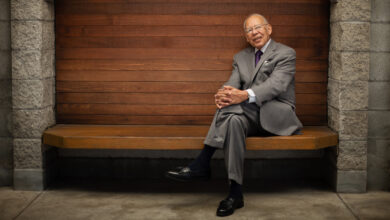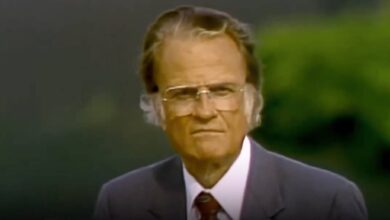Close Encounters of the Elite Institutional Kind

A friend recently recounted a horrible flying experience full of delays, obfuscating explanations, and eventual cancellations. We concluded that one of the most infuriating parts of modern travel is that there is no single person to blame when it falls apart. Most likely, it’s not a failure of this specific pilot or that particular mechanic or this or that airline. It is truly systemic, with a hundred moving processes, none of which have overriding authority over the others.
You can lose your cool in the terminal, but what power does any single employee really hold? You can curse the universe, but alas, it is not moved. If you are a Christian, you can utter a prayer for mercy—I’ve petitioned for such travel miracles but never experienced one myself. It all makes your jaw clench and your stomach turn.
Americans today seem to be in a similar situation as the stranded passenger, directing our rage both in focused and indiscriminate ways across our society, which many see as falling apart.
Since the 1960s, public trust in all types of institutions has plummeted. Since Gallup started tracking survey results, faith in the US Congress has dropped to 8 percent, with newspapers rating at 18 percent, banks at 26 percent, and organized religious institutions at 32 percent. According to these metrics, most institutions have bottomed out in the last two years. Overall, American confidence in institutions has fallen from 48 percent in 1979 to 26 percent in 2023.
Explanations are many and varied. To make sense of the collapsing trust in government, we often cite events like the Watergate scandal and trends of party polarization. Loss of trust in business is often attributed to scandals like Enron and the 2008 banking crisis. Cratering trust in religious institutions is blamed on moral failures, including revelations of systemic sexual abuse. Recent commentators have offered many theories for what historian Matthew Bowman calls “the cynicism and conspiratorialism of American life today.”
Bowman’s new book, The Abduction of Betty and Barney Hill: Alien Encounters, Civil Rights, and the New Age in America, offers a new way to frame the problem in human as well as institutional terms. The results are surprising and welcome.
Bowman uses what has been characterized as the original blueprint for the modern UFO-encounter trope—the abduction of Betty and Barney Hill in rural New Hampshire on September 19, 1961—to explore the cynicism in American society that began in the 1960s and continues today. The book manages to recast big trends in American life through a story that is smaller in scope and more intimate in detail.
A historian at Claremont Graduate University who has written on Mormonism, evangelicalism, and religion and US politics, Bowman is well equipped to tell the Hills’ story. In his account, both the couple’s abduction narrative and its broader reception were deeply influenced by the surrounding social context, which combined the height of American civil religion, the civil rights movement, the Cold War, and the authoritative scientific pronouncements of credentialed experts and government officials.
The Hills’ UFO encounter not only reflected this world but, over time, chipped away at it. They were rejected by military and scientific authorities, and they were simultaneously embraced by competing authorities in the realms of religion, spirituality, and pseudoscience. Their story pried open cultural fissures resembling those in our world today: widespread distrust in both public and private institutions, skepticism toward institutional leaders, dismissiveness toward expertise we don’t already agree with, and the conspiracy thinking at work in many parts of public life.
The encounter
On the night of their claimed abduction, when Betty and Barney Hill witnessed a mysterious “flying saucer” overhead while driving home from Montreal, they were living in Portsmouth, New Hampshire. Betty, 42 years old at the time, was a white social worker and a New Hampshire native. Barney, 39 years old, was an African American postal worker and civil rights activist from Philadelphia. Married in May 1960, they were a rare interracial couple in New England.
The Hills were also Unitarians who attended South Church in Portsmouth. The ethos and assumptions of Unitarianism—and by extension Protestant civil religion—pervaded the Hills’ New England culture. In the 1950s and early 1960s, this meant a progressive theological and political optimism, rooted in a trust of human reason and the American dream, that defined Unitarian beliefs and teachings.
More specifically, in 1961 this meant a seamless religious and social embrace of the civil rights movement. Though the Unitarian denomination was predominantly white, its leaders were notably active in promoting civil rights. The South Church minister installed just six months before the Hills’ fateful September night was a liberal civil rights minister named John Papandrew. His sermons and efforts at community organizing came from a place of deep hope in the capacity of American institutions to reform, and from a confidence that those institutions could effectively better the lives of common people. This faith set up the Hills for repeated disappointments and disillusionment.
Enter the event that made Betty and Barney believe that they had encountered an extraterrestrial UFO. Bowman does not evaluate, as many investigations have before, the veracity of the Hills’ account. He believes their testimony was sincere, but he is guarded in giving it credence. Part of the problem is that the Hills’ narrative evolved over time, with Betty and Barney remembering more details and discovering more memories through hypnosis.
The Hills, channeling their Unitarian optimism in human reason, believed (contra the consensus among professional psychologists) that hypnosis helped to recover accurate but repressed memories. In their case, these included vivid descriptions of an invasive abduction involving small grey aliens with large eyes, a needle that penetrated Betty’s womb, and dozens of medical tests performed on Barney.
Image: WikiMedia Commons / Edits by CT
Betty and Barney Hill
As respectable, progressive members of their community, the Hills looked for validation in the best ways they knew how. They contacted the Air Force and a knowledgeable civilian organization, the National Investigations Committee on Aerial Phenomena (NICAP), met repeatedly with an esteemed psychologist, and eventually invited journalists to document their story.
At each turn, however, they faced increasing scrutiny. The Air Force dutifully received the Hills’ story but did not take it seriously. Psychologist Benjamin Simon, who led both Betty and Barney in multiple sessions of hypnosis, interpreted the findings as evidence of suppressed racial anxieties rather than any external reality. And journalists grew both skeptical and bombastic in recounting the story.
The Hills were active participants in spinning their experiences out of their own control. They actively sought attention and recognition in Portsmouth and beyond, growing increasingly convinced that a conspiracy of suppression was underfoot. With enough national notice, they believed, their narrative would be vindicated.
Resistance and disillusionment
Of course, as Bowman’s subtitle makes clear, this all took place not in a vacuum but in a roiling social and political climate defined by increasing polarization around civil rights. Papandrew, a very public supporter of Betty and Barney, left his South Church pastorate in late 1963 because his sermons and activism had failed to sway the congregation. The people “did not want him to preach things that made them uncomfortable,” Bowman concludes.
Betty and especially Barney began to see their own story falling victim to similar forces. By 1966 the first full journalistic accounts of their abduction were hitting bookshelves. But the increased attention did not provide the breakthrough the Hills were seeking. It mostly made things worse. The couple ditched their psychologist and began to consult with a local psychic, an antiestablishment scientist of parapsychology at Duke University, and a UFO enthusiast who also dabbled in the occult, among others.
These alternative authorities supplied the Hills with a vast array of intellectual and spiritual tools for making sense of their experiences. In describing the spiritual “New Age” that the Hills were entering, Bowman uses the term bricolage to capture the mixing and matching of ideas from the occult, Kabbalah, alchemy, astrology, and the like.
Establishment resistance led to disillusionment across the board. Even as the Civil Rights Act became law, Barney “was beginning to worry that his trust in the power of the state to change minds was unjustified.” This happened locally in Portsmouth as white residents dragged their feet—from the barber shop that refused to integrate to the lawyer that took the barber’s case.
Bowman mentions that Barney never joined the more radical Nation of Islam or embraced the ideology of Black power, which harbored a deep skepticism that American institutions could integrate at all. Yet Barney and the Nation of Islam’s founder, Elijah Muhammad, shared a fascination with UFOs and a faith that “science would reveal the bankruptcy of white America.”
Moreover, Barney interpreted backlash from the scientific establishment and civil rights activism “to be expressions of the same bigotry.” In less than a decade, a cynicism foreign to Unitarian progressivism had captured Betty and Barney—and many Americans besides.
Barney died of a cerebral hemorrhage in 1969, while Betty lived until 2004. The divergent lifespans meant that while Barney remained largely stuck in a place of disillusionment, Betty continued to grapple with her own story in new and increasingly creative ways. Her version of what happened in 1961 continued to develop, and she reported further encounters with UFOs. By the 1970s, she claimed to have witnessed hundreds of visitations.
Her fame increased with a 1975 film starring James Earl Jones as Barney, and her infamy grew when a large portion of one of Carl Sagan’s Cosmos episodes in 1980 was dedicated to debunking the Hills’ story, employing the memorable phrase, “Extraordinary claims require extraordinary evidence.” The establishment, in Betty’s mind, was at it again.
Betty remained a household name among UFO enthusiasts but ultimately lived a life of struggle with the very authorities from whom she sought validation. As Bowman writes, establishment skepticism “frustrated the Hills because it implied to them that their own reasons and perceptions could not be trusted.” Moreover, he concludes, “It seemed catastrophic to them, not only because of their experience but because it implied the nation was run not by its citizens but by a dominant and trained elite.”
In 21st-century parlance, you could call it the “deep state,” the “swamp,” or simply “the elite.” Bowman’s insightful and compelling analysis of the Hills shows their resemblance to many Americans today who trust their own ability to determine the truth while doubting the motives of those who wield expertise and institutional power.
Believing rightly
The Hills’ story helps illustrate that this state of affairs has a deeply personal and experiential component that can’t be captured by invoking either discrete events (like Watergate) or broader patterns (like polarization). The collapse of trust in institutions can’t be pinned exclusively on either a conservative or liberal cast of characters. Nor is it definitively populist or establishmentarian in origin.
The “establishment” began to alienate the Hills through encounters with individual scientists, psychologists, military representatives, and journalists. And Barney’s loss of civil rights optimism occurred not primarily because of white resistance to integration nationally but because of events in Portsmouth.
In other words, individual organizations and entities, including churches and other ministries, have the heavy burden of representing a much larger institutional type in their day-to-day interactions, whether they like it or not. None of us have been mistreated by “the church” or “the state” in some absolute definition of those terms. Yet thousands of us have been mistreated by specific churches, authority structures, and government agencies—by certain manifestations of systemic forces and particular structures of injustice.
This way of reframing the cynicism and conspiratorialism of American life today affects Christians in at least two ways. First, it bears repeating that the Hills were active agents in their own alienation. They misunderstood the purpose and effects of hypnosis, they routinely obfuscated or changed their story, and they resorted to authority sources that were specious at best.
They acted in ways they understood to be consistent with their Unitarian faith—which was not “anti-science” or antiestablishment—and many others in their community spurred them on. Regardless of the details of the Hills’ experience, there were telltale signs that their story was not true or, at best, incomplete and subject to scrutiny. When the truth is obscured in this way, it reflects failures of discipleship, community support, and individual character.
At the same time, the Hills were subject to larger forces that treated them, time and again, as less than fully human. Many people looked to instrumentalize the Hills, and many others looked to suppress, exaggerate, or twist the couple’s experience for their own ends. In Bowman’s telling, very few people who entered the Hills’ life after 1961 regarded them as humans first. Rather, they quickly became pawns in various games of authority, control, or careerism. Bowman’s book is a heartbreaking portrait of the all-too-common American experience of institutional life. No wonder it breeds cynicism.
Some years ago, Dallas Willard observed that “we live in a culture that has, for centuries now, cultivated the idea that the skeptical person is always smarter than the one who believes.” That insight drove those (like the Hills) who doubted the establishment as much as it drives those today who doubt the ability of others to reason toward truths on their own.
Willard’s charge is not to believe indiscriminately but to believe rightly. He concludes the above quote by observing that “the fashion of the age has identified mental sharpness with a pose, not with genuine intellectual method and character.” If cynicism has become the problem in the way Bowman documents, then genuine thinking and living seem the most effective recourses we can summon.
Daniel G. Hummel directs The Lumen Center, a scholarly collective of Christian writers, researchers, and educators on the campus of the University of Wisconsin–Madison. He is the author of The Rise and Fall of Dispensationalism: How the Evangelical Battle Over the End Times Shaped a Nation.




